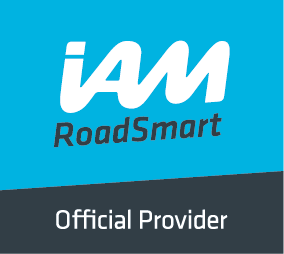To join our group you need to be a current IAM member, to join the IAM click here.
If you are already an IAM member then please get in touch with our group using the contact us link in the menu.
Useful Information from the Highway Code
Motorways
What colour are the reflective studs on a motorway?
There are five different kinds of motorway studs: white, amber, red, green and fluorescent green/yellow. The meaning of these studs are unchangeable so once you have learnt their meanings you can be confident of your position on the motorway.
Green
Where there is a slip road, either on or off the motorway, the reflective studs will be green so that you are aware of these junctions when visibility is poor or if it is dark. This will ensure you can identify the route you need to take off the motorway and be aware when traffic is joining the motorway.
Red
Red reflective studs can be found at the left-hand side of the motorway, in between the lane and the hard shoulder. These are there to make sure you don’t veer out of the left-hand lane into either the hard shoulder or side of the motorway if there is no hard shoulder. Red studs will help you to stay in the left lane if you are driving in the dark or on a misty day.
Amber
You will find amber coloured reflective studs on the right-hand side of the motorway, next to the central reservation. The intention of the amber studs is to keep you in the right-hand lane and away from the central reservation when the conditions are making it difficult for you to see this.
White
White studs are placed in between the lanes on a motorway to help keep you in lane. These work by reflecting the light from your headlights back to you so that you are able to distinguish the different lanes on the motorway if you are caught in a heavy downpour, or you are required to drive late at night.
Fluorescent Green and Yellow Studs
Make sure you are aware of the purpose of green and yellow fluorescent studs on the motorway. This could easily catch you out on your theory test as this motorway stud colour is less common. The purpose of green/yellow studs is to notify drivers of potential adjustments to the road layout due to their being roadworks taking place on the motorway.
What are Red or Flashing Amber Lights on Motorway ?
Motorway flashing amber lights get used to warn traffic of a hazard ahead. The flashing amber signal may also show extra important information.
Examples would be for a temporary maximum speed limit or to show which lanes of the motorway are closed. The flashing speed signs on amber motorway road signs may also display a simple message such as 'Fog'.
If you see amber flashing lights on overhead motorway signs you should adjust the speed of your vehicle. Look out for the source of the danger. Once you pass the danger you will see a signal which is not flashing or one that gives the 'All Clear' message.
Flashing red lights on motorway overhead signs require extra caution. The red ‘X’ signifies that lane is closed. You MUST NOT drive in the lane shown as closed beyond the signal if red lights flash on a signal and a red 'X' is showing.
This applies until you pass another signal indicating that the lane is no longer closed, either by displaying the word 'End' or a speed limit sign.
If red ‘X’ is showing across all lanes of Motorway you must stop and not drive beyond the signs.
You MUST NOT go beyond the signal in any lane if red lights flash on a signal in the central reservation or on the side of the road and lane closed sign is showing.
Stopping distances
What are the stopping distances (as set in highway code)?
SPEED | THINKING DISTANCE | BRAKING DISTANCE | TOTAL DISTANCE | CAR LENGTHS |
20mph (32km) | 6m | 6m | 12m (40’) | 3 lengths |
30mph (48km) | 9m | 14m | 23m (75’) | 6 lengths |
40 mph (64km) | 12m | 24m | 36m (118’) | 9 lengths |
50mph (80km) | 15m | 38m | 53m (175’) | 13 lengths |
60mph (96km) | 18m | 55m | 73m (240’) | 18 lengths |
70mph (112km) | 21m | 75m | 96m (315’) | 24 lengths |
Thinking Distance: The distance it takes to react from when you see the hazard to when your foot applies the brake.
Braking Distance: The distance it takes to stop the car from when the brake is applied. Distance doubles if wet and can be up to 10 times if icy.
Pedestrian Crossings
What are the different types of Pedestrian crossings?
- ZEBRA – Pedestrians
- PELICAN – Pedestrians -timed
- PUFFIN – Pedestrians- sensors
- TOUCAN – Pedestrian and cyclists
- PEGASUS – Horse and pedestrians (sometimes called ‘Equestrian’)
- TRAFFIC LIGHT JUNCTIONS - Pedestrians
Q: How would you recognise a crossing?
A: Belisha beacons
Road signs.
Depending on type of crossing.
- Hint for approaching a pedestrian crossing:
Identify crossing early and use IPSGA on approach.
Several mirror checks.
Scan crossing.
Be prepared to stop.
ZEBRA CROSSINGS
Characterized by Zig Zag markings studded give way markings and Belisha Beacons.
This marks the location of the crossing. Where you see these lights you must be prepared to stop and give way to any pedestrians waiting to cross. Once a pedestrian has stepped onto the crossing you must give way and stop. This is the only crossing that is not controlled by traffic lights.
Be careful not to cross the studded give way area if you cannot clear the crossing ie in queuing traffic. Do not stop on crossing.
Do not park or overtake on Zig Zags.
Beckoning Pedestrians
Q: What are the dangers of beckoning pedestrians across the crossing?
A: You may be putting them in danger as other motorists may not have seen them.
Pelican Crossings
These are controlled by traffic lights but differ to traffic light junctions in that they have a flashing amber phase.
These lights operate on a timed sequence. When amber light flashes you must give way to any pedestrians already on the crossing. If crossing is clear you may proceed.
Puffin Crossings
These are controlled by the normal traffic light sequence but as opposed to being a timed sequence they have sensors.
The crossing is activated by pedestrians pressing button on yellow box. When signals change to red for traffic sensors will sense movement on crossing and keep the lights at red until no movement is detected.
Toucan Crossing
Designed to be used by pedestrians and cyclists and work in same way as pelican crossings with exception of having NO flashing amber.
The cyclist does not need to dismount. If they cross at other crossings they need to dismount and walk.
There is usually a cycle lane either side of the crossing as they approach. Some have cycle lanes across the road.
Pegasus (Equestrian) Crossing
These are where a bridleway crosses the road. The sequence and meaning of lights at this crossing are the same as a Toucan.
At the side of the crossing there will be a fenced area for horses to wait. It may be the case that both pedestrians and horses may cross at this type of crossing if that is the case there may be two separate crossings.
Traffic Light Junctions
A pedestrian crossing can be incorporated into normal traffic light junction. It is still operated by push button and the crossing area clearly marked by two rows of studs.
When you should treat crossings as one or two.
Zebra crossing
If an island is in the middle and there are two sets of Belisha beacons, treat as two.
Pelican crossing
If staggered and with an island and two sets of lights, treat as two
School Crossing Patrol
Flashing lights on a warning sign inform drivers that a school crossing patrol is ahead.
You must give way to Lollipop person on duty and be particularly careful as children will be crossing the road.

